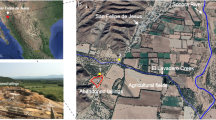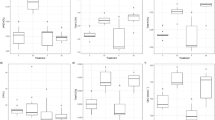Abstract
Phosphogypsum is a by-product of the phosphorus fertilizer production process and is typically stacked at the production sites. These stacks can potentially pose environmental hazards, which can be substantially reduced through reclamation by capping with soil and revegetation upon decommissioning. We conducted a study on a phosphogypsum stack using five soil capping depths (8, 15, 30, 46, 91 cm), an uncapped treatment, and five vegetation treatments (monocultures of four grass species Agrostis stolonifera L., Festuca ovina L., Deschampsia caespitosa (L.) Beauv., Agropyron trachycaulum (Link) Malte ex H.F. Lewis and one mix of the four species with Trifolium hybridum L.) to assess plant growth, health, rooting characteristics, and trace element uptake. Cobalt and nickel concentrations in plant tissue from plots with ≥ 15 cm soil capping were within ranges found at reference sites, whereas fluorine was three times elevated. Vegetation cover was significantly greater on capped than uncapped plots, being greatest for Agropyron trachycaulum (26%) and Festuca ovina (26%). Capping depths ≥ 15 cm had greater cover, biomass, and healthy plants than the 8 cm cover. Soil water content was similar in the 15–46 cm capping depth, with the lowest in the 91-cm caps. Fluorine, cobalt, and nickel were elevated in select plant tissue samples on the research plots relative to references, and cap depth affected tissue fluorine and cobalt concentrations but not nickel. Concentrations of these trace elements were lower than maximum tolerable levels for animal consumption. From this 5-year study, Agropyron trachycaulum and Festuca ovina and a soil cover depth of ≥ 15 cm are recommended for reclamation of phosphogypsum stacks.

Similar content being viewed by others
Data availability
The data presented in this study are available on request from the corresponding author. The data are not publicly available due to copyright issue.
References
Ahmad MS, Ashraf M (2011) Essential roles and hazardous effects of nickel in plants. Rev Environ Contam Toxicol. 214:125–167. https://doi.org/10.1007/978-1-4614-0668-6_6
Al-Hwaiti M, Ibrahim KA, Harrara M (2019) Removal of heavy metals from waste phosphogypsum materials using polyethylene glycol and polyvinyl alcohol polymers. Arab J Chem 12:3141–3150. https://doi.org/10.1016/j.arabjc.2015.08.006
Al-Oudat M, Arslan A, Kanakri S (1998) Physical and chemical properties, plant growth, and radionuclide accumulation effects from mixing phosphogypsum with some soils. Commun Soil Sci Plant Anal 29:2515–2528. https://doi.org/10.1080/00103629809370129
Alberta Environment (2008) Operating approval under the Environmental Protection and Enhancement Act. Approval No. 20477-01-00. Approval holder: Agrium Products Inc., Fort Saskatchewan AB. Effective date December 18, 2008. 27 pp
Alberta Environment and Parks (2019) Alberta tier 1 soil and groundwater remediation guidelines. Land Policy Branch, Policy and Planning Division Edmonton AB. 198 pp. https://open.alberta.ca/publications/1926-6243. Accessed 16 Nov 2021
Baldwin CM, Liu H, McCarty LB, Luo H, Wells CE, Toler JE (2009) Impacts of altered light spectral quality on warm-season turfgrass growth under greenhouse conditions. Crop Sci. 49:1444–1453. https://doi.org/10.2135/cropsci2008.07.0412
Bituh T, Petrinec B, Skoko B, Babić D, Rašeta D (2021) Phosphogypsum and its potential use in Croatia: challenges and opportunities. Arh Hig Rada Toksikol 72:93–100. https://doi.org/10.2478/aiht-2021-72-3504
Boldt-Burisch K, Naeth MA (2019) Phosphogypsum significantly alters root growth and fungal colonization of smooth brome and sheep fescue on a reclamation site. Rhizosphere 9:106–109. https://doi.org/10.1016/j.rhisph.2018.12.003
Chernysh Y, Yakhnenko O, Chubur V, Roubík H (2021) Phosphogypsum recycling: a review of environmental issues, current trends, and prospects. Appl Sci 11:1575. https://doi.org/10.3390/app11041575
Dhar A, Comeau PG, Karst J, Pinno B, Chang S, Naeth MA, Vassov R, Bampfylde C (2018) Plant community development following reclamation of oil sands mine sites in the boreal forest: a review. Environ Rev 26:286–298. https://doi.org/10.1111/rec.13039
Elloumi N, Zouari M, Chaari L, Abdallah FB, Woodward S, Monem K (2015) Effect of phosphogypsum on growth, physiology, and the antioxidative defense system in sunflower seedlings. Environ. Sci Pollut Res 22:14829–14840. https://doi.org/10.1007/s11356-015-4716-z
Environment Canada (2021) Canadian climate normals 1981–2010 station data. https://climate.weather.gc.ca/climate_normals/index_e.html. (Accessed 10 November 2021)
Fuleihan NF, Ingra TS, Home R (2005) Hydrologic evaluation of final cover system alternatives for closure of phosphogypsum stacks. Publication No. 03-126-212. FIPR. Prepared by: Ardaman and Associates, Inc. Bartow, FL. pp. 345
Fuleihan NF (2012) Phosphogypsum Disposal - The pros & cons of wet versus dry stacking. Procedia Eng 46:195–205. https://doi.org/10.1016/j.proeng.2012.09.465
Government of Alberta (2019). Environmental protection and enhancement act (EPEA). Revised Statutes of Alberta 2000 Chapter E-12. https://www.qp.alberta.ca/documents/Acts/E12.pdf (Accessed 16 November 2021)
Government of Alberta (2003) Soil pH and plant nutrients. Agri-Facts, Government of Alberta. https://open.alberta.ca/dataset/2818770. (Accessed 14 December 2021)
Guéablé YKD, Bezrhoud Y, Moulay H, Moughli L, Hafidi M, El Gharouss M, El Mejahed K (2021) New approach for mining site reclamation using alternative substrate based on phosphate industry by-product and sludge mixture. Sustainability 13:10751. https://doi.org/10.3390/su131910751
Gusev AP (2006) Primary succession on phosphogypsum dumps (Gomel Chemical Plant, Belarus). Russ J Ecol 37:210–212. https://doi.org/10.1134/S1067413606030118
Hallin IL, Naeth MA, Chanasyk DS, Nichol CK (2010) Assessment of a reclamation cover system for phosphogypsum stacks in Central Alberta. J Environ Qual 39:2160–2169. https://doi.org/10.2134/jeq2010.0432
Jackson M, Naeth MA, Chanasyk DS, Nichol CK (2011) Phosphogypsum capping depth affects revegetation and hydrology in western Canada. J Environ Qual 40:1122–1129. https://doi.org/10.2134/jeq2010.0100
Kabata-Pendias A (2011) Trace elements in soils and plants, 4th edn. Taylor & Francis Group, Boca Raton, p 520
Komnitsas K, Laxar I, Petrisor IG (1999) Application of a vegetative cover on phosphogypsum stacks. Miner Eng 12:175–185. https://doi.org/10.1016/S0892-6875(98)00130-7
Kumar K, Giri A, Vivek P, Kalaiyarasan T, Kumar B (2017) Effects of fluoride on respiration and photosynthesis in plants: an overview. Ann Environ Sci Toxicol 2:43–47. https://doi.org/10.17352/aest.000011
Macías F, Pérez-López R, Cánovas CR, Carrero S, Cruz-Hernandez P (2017) Environmental assessment and management of phosphogypsum according to European and United States of America regulations. Procedia Earth Planet Sci 17:666–669. https://doi.org/10.1016/j.proeps.2016.12.178
May A, Sweeney JW (1984) In: Kuntze RA (ed) Assessment of environmental impacts associated with phosphogypsum in Florida. The Chemistry and Technology of Gypsum. ASTM International, West Conshohocken, pp 116–139. https://doi.org/10.1520/STP30276S
Natural Regions Committee (2006) Natural regions and subregions of Alberta. Compiled by D.J. Downing and W.W. Pettapiece. In: Government of Alberta Publication T/852, Edmonton, AB, Canada
Patel SK, Eericson WA, Richardson SG, Sartain JB (1996) The engineering properties of phosphogypsum for stack closure. Environ Geotech 2:893–897
Plyatsuk L, Balintova M, Chernysh Y, Demcak S, Holub M, Yakhnenko E (2019) Influence of phosphogypsum dump on the soil ecosystem in the Sumy region (Ukraine). Appl Sci 9:5559. https://doi.org/10.3390/app9245559
Prysedskyi Y, Mashtaler M (2021) Growth parameters of herbaceous plants on phosphogypsum dumps with using soil coverings based on sewage sludge. J Ecol Eng 22:20–26. https://doi.org/10.12911/22998993/134247
Richardson SG, Johnson CD, Patel SK (1995) Establishing vegetation cover on phosphogypsum in Florida. Publication No. 01-086-116. Florida Institute of Phosphate Research. Bartow FL. 70 pp.
Robinson MJC (2018) Phosphogypsum reclamation: evaluating alternative and traditional cover systems. In: MSc Thesis. Department of Renewable Resources. University of Alberta, Edmonton, p 119
Rutherford PM, Dudas MJ, Arocena JM (1995) Radioactivity and elemental composition of phosphogypsum produced from three phosphate rock sources. Waste Manag. Res. 13:407–423. https://doi.org/10.1177/0734242X9501300502
Rutherford PM, Dudas MJ, Samek RA (1994) Environmental impacts of phosphogypsum. Sci Total Environ 149:1–38. https://doi.org/10.1016/0048-9697(94)90002-7
Saadaoui E, Ghazel N, Romdhane CB, Massoudi N (2017) Phosphogypsum: potential uses and problems. Int J Environ Stud 74:558–567. https://doi.org/10.1080/00207233.2017.1330582
Taiz L, Zeiger E (2010) Plant physiology, 5th edn. Sinauer Associates Inc., Sunderland, p 782
Tayibi H, Choura M, Lopez FA, Alguacil FJ, Lopez-Delgado A (2009) Environmental impact and management of phosphogypsum. J Environ Manage 90:2377–2386. https://doi.org/10.1016/j.jenvman.2009.03.007
Thorne WER (1990) Reclamation of a phosphogypsum tailings pond: an examination of the relevant issues. M.E.Des. Thesis. Department of Environmental Science, University of Calgary, Alberta, pp. 330
United States Department of Agriculture (2010) The plants database. National Plant Data Center. On line at http://plants.usda.gov (Accessed 12 October 2021)
United States National Research Council (2005) Mineral tolerance of animals, 2nd edn. Subcommittee on Mineral Toxicity in Animals. National Academic Press, Washington DC, p 510
Acknowledgements
We would like to thank Dr. Miles Dyck, Andre Christensen, and Dick Purveen for technical support with field and lab work. Parts of the text have been previously published as partial requirements for the MSc thesis of Lenore E. Turner (previously Elizabeth (Lenore) Turner) at University of Alberta.
Funding
This research was funded by the National Sciences and Engineering Research Council (NSERC), industrial postgraduate scholarship, and Agrium.
Author information
Authors and Affiliations
Contributions
The study conception and design were contributed by M. Anne Naeth, David Chanasyk, and Connie Nichol. Material preparation and data collection were performed by Lenore Turner. Data analysis was performed by Lenore Turner and Amalesh Dhar. The first draft of the manuscript was written by Amalesh Dhar, and all authors commented on previous versions of the manuscript. All authors read and approved the final manuscript.
Corresponding author
Ethics declarations
Ethics approval
Not applicable.
Consent to participate
Not applicable.
Consent for publication
Not applicable.
Competing interests
The authors declare no competing interests.
Additional information
Responsible Editor: Kitae Baek
Publisher's note
Springer Nature remains neutral with regard to jurisdictional claims in published maps and institutional affiliations.
Supplementary Information
Below is the link to the electronic supplementary material.
Rights and permissions
About this article
Cite this article
Turner, L.E., Dhar, A., Naeth, M.A. et al. Effect of soil capping depth on phosphogypsum stack revegetation. Environ Sci Pollut Res 29, 50166–50176 (2022). https://doi.org/10.1007/s11356-022-19420-7
Received:
Accepted:
Published:
Issue Date:
DOI: https://doi.org/10.1007/s11356-022-19420-7




